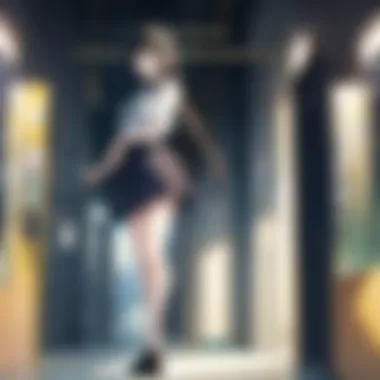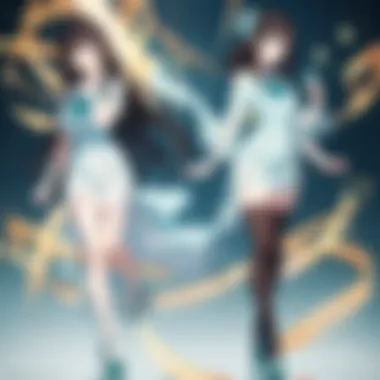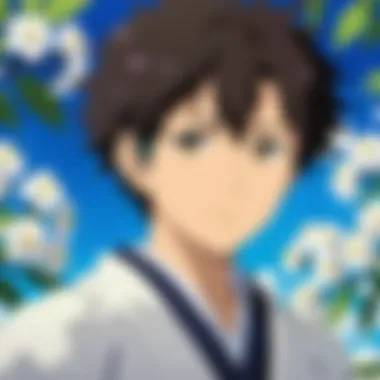Exploring Hyouka: A Deep Dive into the Anime


Intro
'Hyouka' is not just another anime series; it captures a slice of life infused with intellectual curiosity and subtle beauty. Available on Crunchyroll, the series has garnered attention for its intricate storytelling and its profound character development. This article tries to peel back the layers of 'Hyouka', aiming to provide insights into its themes, characters, and what makes it a significant player in contemporary anime.
Character Profiles
Overview of Main Characters
The characters in 'Hyouka' are complex, each offering a different lens through which to view the world. Houtarou Oreki serves as the series' protagonist. He is a high school student known for his energy conservation philosophy. This makes him reluctant to engage in activities unless absolutely necessary. However, his unique approach to problems reveals a keen intellect that becomes central to the series' mystery-solving elements.
Eru Chitanda, on the other hand, provides a contrasting foil to Houtarou. With her boundless curiosity and innocent demeanor, she invites him to explore mysteries, thus igniting a dynamic push-pull between the two. Chitanda’s catchphrase, "I have a curiosity," emphasizes her role in challenging Houtarou's indifference.
Supporting Characters
Supporting characters play crucial roles in shaping the narrative and contributing to the main themes. Satoshi Fukube and Mayaka Ibara round out the main group. Satoshi represents a mix of humor and intelligence, providing insights that add depth to various situations. Mayaka, a passionate librarian, often embodies a sense of duty. Her character explores the idea of personal responsibility.
Together, these characters create an intricate web of relationships that elevate the series, allowing viewers to engage not just with the plot but with each individual's growth and interactions.
Theme Exploration
Central Themes
At its core, 'Hyouka' explores notions of curiosity and the pursuit of knowledge. The anime intricately weaves a narrative about how daily experiences hold hidden meanings. Through engaging mysteries, the characters often confront their own limitations and the societal expectations that surround them. The theme of "energy conservation" as upheld by Houtarou reflects deeper philosophical ponderings about life choices and existential purpose.
Cultural References
'Hyouka' is filled with cultural references that enrich its narrative. From the details of Japanese school life to allusions to classic literature, each element serves to immerse the viewer in a richly constructed world. This background gives a deeper understanding of the characters' motivations and struggles, adding layers to the viewing experience.
Popular Series and Recommendations
Top Anime Series of the Year
While 'Hyouka' stands out, several other series have made waves this year. Titles like Attack on Titan and Demon Slayer have captivated audiences with their animation and strong narratives. These offerings demonstrate how different anime can appeal to various elements of storytelling.
Hidden Gems in Manga
For those who appreciate the depth of 'Hyouka', exploring lesser-known manga might also be rewarding. Works like A Silent Voice and March Comes in Like a Lion delve deep into emotional storytelling, echoing the nuanced style found in 'Hyouka'. Each narrative offers something unique for the discerning reader.
“In the unassuming, there often lies the profound.”
This exploration of 'Hyouka' highlights its importance in both the anime landscape and the broader cultural conversation. By understanding its characters, themes, and significance, viewers can gain a richer appreciation of what this series offers.
Overview of Hyouka
The section on Overview of Hyouka serves as a vital introduction to the anime's narrative and thematic scope. This foundational understanding is essential for readers seeking to grasp the complex layers embedded in the series. By outlining the plot and identifying specific features of the series, this section prepares the audience for a deeper examination of characters, themes, and visual styles later in the article.
In this exploration, readers will gain insight into the main storyline and the pivotal elements that distinguish Hyouka from other anime. Key aspects are not just about the narrative; they include how the series presents ordinary life with an underlying mystery, enticing viewers to watch intently. Awareness of these elements elevates appreciation of the series and encourages a critical perspective on what unfolds both on the screen and within the interpersonal dynamics of the characters.
Basic Plot Summary
Hyouka follows the life of Houtarou Oreki, a high school student characterized by his lethargic nature. He prefers to conserve energy and avoid unnecessary activities. However, his outlook changes when he is coerced into joining the Classic Literature Club by his enthusiastic classmate Eru Chitanda. The club is a remnant of the school's activities, but it soon becomes the center for various mysteries.
Throughout the series, Houtarou, with his exceptional analytical abilities, encounters different enigmas connected to the club's past, each demanding resolution. The intent is not just to solve mysteries for the sake of solving them, but to explore the significance of these challenges within the routine fabric of high school life. The everyday setting combined with intellectual curiosity highlights the brilliance of Hyouka.
Unique Aspects of the Series
Hyouka presents itself as a blend of slice-of-life and mystery genres, weaving a narrative that feels unique. Its pacing and structure diverge from typical shounen narratives filled with action. Some unique aspects include:


- Character-Driven Narratives: The emphasis is on characters and relationships rather than overt conflict or competition. Each mystery reflects personal growth and how characters interact around common issues.
- Visual Representation: The art style is remarkable for its detailed backgrounds and subtle animations. These contribute to creating a sense of realism that enriches the experience.
- Thoughtful Pacing: Unlike most anime, Hyouka does not rush through plot developments or character arcs. This slow pace allows viewers to savor each little moment, drawing them subtly into the world.
- Intellectual Engagement: Each mystery posed is designed not just for entertainment but for reflection. The solutions often reflect deeper themes and moral questions interwoven through the series.
The combination of these elements makes Hyouka distinctively intriguing and intellectually stimulating. It challenges the audience to engage not just with the mystery presented, but with the subtleties of everyday interactions.
Thematic Exploration
Thematic exploration provides a foundation for understanding the complex narrative of Hyouka. By analyzing the themes within the show, viewers can gain insight into the overarching messages and artistic intentions the creators intended to convey. This article seeks to illuminate these themes, which serve as a lens through which to appreciate the characters and plot.
Themes of Curiosity and Mystery
Curiosity stands out as a defining theme in Hyouka. The protagonist, Houtarou Oreki, embodies a natural inclination to avoid unnecessary effort. However, as he navigates various mysteries, his curiosity is piqued, revealing a deeper engagement with the world around him. The show illustrates how curiosity can unravel complex situations and relationships. Every episode presents a new puzzle, inviting viewers to participate in the investigative process alongside the characters.
In the context of mystery, Hyouka does not conform to traditional approaches often seen in detective genres. Instead of focusing on crime-solving, the mysteries in Hyouka revolve around everyday life, social dynamics, and the subtle intricacies of human behavior. This approach reflects the series' belief that even the mundane can reveal significant truths. Simply put, the show elevates ordinary experiences to an art form, making the quest for answers both relatable and profound.
For viewers, each revelation is not just a resolution to a mystery but also an invitation to reflect on their motivations and desires. As Oreki interacts with characters like Eru Chitanda, the tension between his apathetic nature and her vibrant curiosity highlights the transformative power of interpersonal relationships.
The Role of Everyday Life
Everyday life serves as the canvas upon which the narrative of Hyouka unfolds. Unlike many anime that venture into fantasy or historical settings, this series takes place in a contemporary high school. The relatable backdrop allows viewers to connect the themes and characters to their own lives.
The mundane activities—school clubs, classroom discussions, and local events—accentuate the show’s essence. By exploring how common activities can lead to significant revelations, Hyouka presents a compelling argument: that life’s simplicity often conceals deeper meanings. These themes resonate especially well with anime and manga enthusiasts, who appreciate a slice-of-life narrative that juxtaposes profound ideas against a standard backdrop.
The film also subtly critiques how society often undervalues the mundane. It proposes that through engaging with everyday moments, one can craft a life filled with intrigue and knowledge. The protagonists showcase that the ordinary and the extraordinary are often intricately intertwined.
"Hyouka challenges viewers to embrace the complexities within the simplicity of everyday life, suggesting that each moment holds the potential for discovery."
In summary, the thematic exploration of Hyouka not only enhances the understanding of the narrative but also invites deeper contemplation of the human experience. The interplay between curiosity, mystery, and the mundane cultivates a rich viewing experience, rendering this anime a significant piece in the contemporary landscape.
Character Analysis
Analyzing characters in Hyouka reveals much about the show’s narrative structure and thematic depth. Character development serves as a vehicle for showcasing the ideas of curiosity, observation, and individual growth. Each character’s journey is intertwined with the central themes, which elevates the viewing experience. Understanding these arcs provides insights into the overall message of the anime, highlighting how personal connections foster learning and discovery.
Houtarou Oreki's Character Development
Houtarou Oreki, the protagonist, embodies the tension between apathy and curiosity. Initially, he is indifferent, preferring to conserve his energy and avoid unnecessary involvement. However, his encounters with Eru Chitanda serve as a catalyst for change. As the series progresses, Houtarou transitions from a passive observer to an active participant. This internal struggle reflects a key theme in Hyouka: the idea that curiosity can lead to personal growth.
His evolution is subtle yet profound, marked by small moments of realization that shift his perspective. The mysteries he solves not only reveal truths about others but also prompt self-reflection. By the end of the series, Houtarou learns the value of connection and the knowledge that comes from engaging with the world around him.
Eru Chitanda's Influence on the Narrative
Eru Chitanda is essential to the development of Houtarou’s character and the narrative as a whole. Her relentless curiosity and enthusiasm are infectious, challenging Houtarou’s initial lethargy. Chitanda's catchphrase, "I'm curious!" acts like a beacon, guiding the plot forward and urging the audience to engage with the mysteries presented.
Moreover, her ability to draw out Houtarou’s investigative skills makes her a pivotal figure in the story. The dynamic between the two provides a fascinating exploration of how personal relationships can inspire change. Chitanda embodies the theme of curiosity, serving both as the driving force behind Houtarou’s transformations and a lens through which viewers experience the unfolding mysteries.
Supporting Characters and Their Roles
The supporting characters in Hyouka play significant roles in enriching the narrative and shedding light on Houtarou and Chitanda’s development. Characters like Satoshi Fukube and Mayaka Ibara add layers to the group dynamic, each representing different approaches to curiosity and involvement.
- Satoshi Fukube serves as a foil to Houtarou, embodying a more enthusiastic and sociable disposition. His analytical mind offers unique perspectives that encourage Houtarou to think differently.
- Mayaka Ibara, on the other hand, introduces a dose of realism and challenges the other characters’ ideas through her pragmatic approach. Her artistic sensibilities and critical opinions further deepen the exploration of hobbies and passions.
Together, these characters form a rich tapestry that enhances the main plot. They also reflect the various facets of curiosity—whether it leads to personal connections, artistic expression, or deeper understanding.
The collective character dynamics within Hyouka craft an engaging narrative that not only explores individual growth but also the impact of relationships on the pursuit of knowledge.
Art and Animation Style
Art and animation play critical roles in establishing the identity of any anime series. For Hyouka, the artistic direction and animation techniques contribute significantly to the storytelling and the viewer's immersion. The visuals not only provide aesthetic enjoyment but also enhance the emotional undertones and thematic depth of the narrative. Understanding the art and animation style in Hyouka allows audiences to appreciate the delicate craftsmanship behind this series.
Visual Aesthetics


The visual style of Hyouka is distinctive and serves as a reflection of its narrative and characters. The use of color is particularly noteworthy. Soft, pastel tones create a calming atmosphere, aligning with the often slow-paced and contemplative nature of the show. The backgrounds are meticulously detailed, illustrating an array of settings—from the vibrant school environment to the serene countryside—each framed in a way that supports the story.
Character designs further emphasize individuality. Each character's appearance is carefully crafted to match their personality traits. For instance, Eru Chitanda’s bright and lively features contrast sharply with Houtarou Oreki’s more muted and reserved style. This difference tells viewers much about their roles and dynamics within the story without needing exposition.
"In Hyouka, every visual element is purposefully designed to complement the narrative."
Animation Techniques Used
The animation techniques employed in Hyouka are noteworthy for their fluidity and attention to detail. One of the primary techniques utilized is limited animation, which allows for more expressive facial movements without overwhelming the viewer with constant motion. This style effectively conveys subtle emotions, making quiet moments resonate deeply.
Another significant aspect is the use of dynamic camera angles. Hyouka masterfully employs shifts in perspective to enhance storytelling. For example, during key scenes in club activities or investigations, the framing choices create tension and emphasize the characters’ interactions.
Additionally, Hyouka takes full advantage of light and shadow. The way sunlight filters through classroom windows or reflects off surfaces adds another layer of depth to scenes. This not only showcases the artistic skills of the animation team but also amplifies the contemplative mood that Hyouka is known for.
In summary, the art and animation style in Hyouka is integral to its success. The combination of thoughtful visual aesthetics and innovative animation techniques encourages viewers to engage with the story on a deeper level.
Reception and Impact
In analyzing Hyouka, the topic of reception and impact serves as a critical lens through which one can appreciate its significance within the anime community. This series, known for its slow-burn narrative and rich character interactions, has elicited varied responses from critics and audiences alike. A comprehensive understanding of how Hyouka is received helps underline its contributions to the medium and its lasting impressions.
Critical Reception Overview
Critics generally praised Hyouka for its unique storytelling approach and character depth. The anime has been noted for its ability to blend suspense and slice-of-life elements seamlessly. Websites like MyAnimeList and AniList reflect a favorable consensus, often rating it near the top of various lists. Reviews frequently highlight the intricate animation by Kyoto Animation, which elevated the visual storytelling.
One major aspect of the critical reception is how Hyouka tackles mystery not through overt action but instead through subtlety and character dynamics. Many reviewers underscore this as a refreshing approach when compared to other works in the mystery genre. The pacing, while slower than most traditional anime, allows viewers to engage more deeply with character development. Critics point out that the anime thrives on its dialogues and interactions rather than a fast-paced plot.
"Hyouka proves that not all mysteries need to be solved within the confines of urgency. Instead, it invites viewers to unravel them over time, providing a deeper understanding of its characters and themes." – Anime News Network
Audience Reactions
Audience reactions to Hyouka display a strong divide between those who appreciate its slow pacing and those who prefer more action-driven narratives. Fans of slice-of-life and character-driven stories seem to gravitate toward Hyouka's nuanced approach. Many viewers on forums like Reddit engage in discussions, highlighting how the series prompts viewers to reflect on their own curiosities and the mundane aspects of everyday life.
On the other hand, some viewers find the slow pacing frustrating. They tend to view the series as lacking in tension, preferring faster reveals typical of the mystery genre. This divide in audience reception adds to Hyouka's complexity, as it invites varied interpretations based on individual viewing preferences.
Furthermore, viewer engagement on platforms like Facebook reflects a strong community built around the anime. Fans often share their analyses and theories surrounding character motives and underlying themes. This interaction not only sustains interest in the series but also exhibits its impact on discussions about anime at large.
In summary, the reception and impact of Hyouka reveal the anime’s ability to challenge conventional storytelling through a blend of mystery and everyday life. This duality has fostered both praise and critique, making Hyouka a lasting topic of discussion among anime enthusiasts.
Cultural Significance
The cultural significance of Hyouka extends beyond its narrative and aesthetics. This anime is a reflection of various aspects of Japanese society, attitudes, and values. By examining this series, one gains insight into how contemporary anime engages with themes that resonate with its audience. It captures the essence of youth, curiosity, and the struggle between personal desires and societal expectations. This resonates particularly well within Japanese culture, known for its focus on harmony and individual roles within a group.
Moreover, Hyouka emphasizes the importance of intellectual engagement and the pursuit of knowledge. Its characters, particularly Houtarou Oreki, showcase the tension between apathy and curiosity. This conflict can be interpreted not only as a personal journey but also as a societal commentary, reflecting a youth culture torn between the pressures to conform and the desire for self-discovery.
Hyouka in Context of Japanese Culture
In Hyouka, the setting is crucial. The depiction of high school life resonates with many viewers. High schools in Japan often serve as microcosms of society, where students navigate complex relationships. The series highlights various cultural practices, such as the importance of clubs and school festivals, which symbolize community and collaboration.
This is evident through the Literature Club, where characters like Eru Chitanda and Satoshi Fukube engage in mystery-solving alongside their academic pursuits. The blend of friendship, puzzling mysteries, and day-to-day activities reflects the priorities and nuances in the lives of Japanese youth.
In addition, the series portrays the significance of traditional Japanese values—respect, diligence, and introspection. Houtarou’s eventual growth mirrors a societal expectation to contribute meaningfully to the community rather than simply existing. This cultural lens enriches the viewing experience, prompting audiences to reflect on their own roles within society.
Influence on Other Anime Series
Hyouka has left a mark on subsequent anime, particularly within the slice-of-life and mystery genres. The series has demonstrated that mystery does not need to adhere to the fast-paced, thrilling norms seen in many traditional mystery stories. Instead, it highlights that the mystery can arise from ordinary life, prompting a deeper examination of seemingly trivial details.
Notably, the focus on character development and subtle storytelling has paved the way for other series. For instance, anime like March Comes in Like a Lion incorporates similar themes of introspection and the effects of personal relationships on growth. Another example is My Youth Romantic Comedy Is Wrong, As I Expected, merging slice-of-life with engaging character dynamics while exploring social commentary.


The approach taken by Hyouka has influenced how mystery and everyday life are depicted in anime, encouraging subsequent creators to explore deeper themes and character relationships. The resonance of its cultural significance creates a lasting legacy, encouraging future narratives to balance the ordinary with the extraordinary.
Availability on Crunchyroll
The availability of Hyouka on Crunchyroll holds significant value for fans and new viewers alike. As a popular streaming platform, Crunchyroll provides a legal way to access anime series. This legality is important, as it supports the original creators and the anime industry as a whole. Crunchyroll also offers multiple viewing options, making it easier for users to engage with Hyouka in their preferred manner.
Streaming Details
Crunchyroll has made Hyouka accessible through its streaming service, allowing users to watch the series in various resolutions. This flexibility caters to different internet speeds and device capabilities, ensuring that fans can enjoy the show without interruption. The platform supports both subbed and dubbed versions, giving viewers a choice that aligns with their preferences. Users can find completed seasons available, which encourages binge-watching without waiting for newer episodes.
In terms of user experience, Crunchyroll offers a seamless interface, making navigation between episodes straightforward. Users can create personal watchlists and even receive recommendations based on their viewing history, fostering a tailored entertainment experience. This interface enhances the enjoyment of anime series like Hyouka.
Subscription and Viewing Options
There are several subscription options available for users wishing to experience Hyouka on Crunchyroll. The basic free membership grants access to most content with ads, allowing viewers to start watching immediately. However, for those desiring an ad-free experience, premium memberships are offered. Premium options include ad-free streaming, access to simulcasts within an hour of airing in Japan, and exclusive content. This tiered subscription model allows users to choose the level of engagement they want, whether they prefer casual viewing or a more immersive experience.
Additionally, Crunchyroll’s app is available on multiple platforms. This ensures that fans can view Hyouka on their smartphones, tablets, or smart TVs. The flexibility of viewing also extends to offline watching, where episodes can be downloaded for later enjoyment. This consideration adds significant convenience for those with limited internet access or those traveling.
"Crunchyroll not only provides access to Hyouka, but nurtures community around anime fandom through its engaging features and ease of use."
Comparative Analysis
Comparative analysis in the context of Hyouka serves as a key approach to understand its unique position within the anime landscape. By systematically evaluating this series against both slice-of-life animes and traditional mystery genres, one can uncover the notable characteristics that set it apart. This analysis not only highlights the distinctive narrative techniques used in Hyouka but also illustrates how it reflects or deviates from established genre norms. Engaging in comparative analysis provides a framework that helps viewers appreciate the subtleties of character development and thematic elements that permeate the story.
Comparison with Other Slice-of-Life Animes
When comparing Hyouka with other slice-of-life animes, several key elements emerge. Unlike traditional slice-of-life narratives that often prioritize interpersonal relationships and humor, Hyouka delves into intellectual curiosity and mystery. This series often reflects on mundane moments yet layers them with deeper meanings.
One notable point of comparison is with series like Clannad and March Comes in Like a Lion. While these shows explore emotional depth and character growth through personal struggles, Hyouka engages viewers through the lens of intrigue and problem-solving.
- Narrative Structure: In Hyouka, the episodic format is utilized to build suspense and present puzzles to be solved, differing from the more direct storytelling common in other slice-of-life series.
- Character Focus: The characters in Hyouka are portrayed with an emphasis on their motivations in solving mysteries, contrasting with characters in shows like Anohana where emotional resolutions take precedence.
Furthermore, Hyouka utilizes the school setting as a backdrop for exploration, similar to K-On! but with a markedly different tone—one that favors logical reasoning over casual camaraderie.
Contrasting Hyouka with Traditional Mystery Genre
The juxtaposition of Hyouka against the traditional mystery genre reveals critical differences that define its narrative style. Most mystery stories emphasize suspense and resolution. They typically build towards a climax where the mystery is unraveled in a dramatic fashion. In contrast, Hyouka employs a more subtle approach, often focusing on the process of investigation rather than the final revelation of truths.
- Character Motivation: In most mystery genres, protagonists are driven by external stakes or dangers. However, Houtarou Oreki's motivation stems more from curiosity and a desire to avoid unnecessary effort.
- Resolution Style: While traditional mystery tales often conclude with a clear answer, Hyouka maintains an ambiguous ending in many of its arcs. This establishes a philosophical take on problem-solving, where not all mysteries need resolution.
The series also differentiates itself by blending the mundane with the extraordinary. This leaves viewers contemplating the complexities of everyday life rather than merely focusing on whodunits.
"Hyouka reshapes the mystery narrative, focusing not on the conclusion, but on the journey of discovery that engages both characters and viewers alike."
In summary, the comparative analysis elucidates Hyouka's distinct narrative choices within slice-of-life and mystery genres. This approach enhances appreciation for its layered storytelling and encourages deeper inquiry into the factors that enrich the viewer's experience.
Culmination
The conclusion of this article is significant in reinforcing the various elements discussed about Hyouka. It brings together the intricate themes, character arcs, and cultural relevance of the anime, allowing readers to appreciate its depth and beauty. By summarizing key insights, the conclusion facilitates a holistic view that enhances understanding among viewers, especially those new to the series.
Summarizing Key Insights
In reviewing Hyouka, several key insights emerge:
- Thematic depth: The series explores curiosity, everyday life, and the nuances of human emotion, which adds richness to its storytelling.
- Character development: Houtarou Oreki's growth and Eru Chitanda's influence create a compelling dynamic that drives the narrative forward.
- Cultural reflection: The anime serves as a window into Japanese culture, articulating attitudes and ideologies prevalent among youth.
- Artistic expression: The unique visual style and meticulous animation techniques contribute to the overall experience, making it visually arresting.
- Impact on the anime community: Hyouka stands as a benchmark for slice-of-life narratives and has influenced subsequent works in the genre.
These points shed light on why Hyouka remains a relevant and cherished piece of anime.
Future of Hyouka in Anime
Looking ahead, the future of Hyouka in the anime landscape seems promising. The series has garnered a devoted fanbase, and its exploration of themes like curiosity could continue to inspire future anime productions.
Moreover, should the creators decide to revisit the story or its characters, there is a strong potential for a revival or sequel. As anime continues to evolve, integrating elements from Hyouka could lead to innovative approaches within the genre.
In summary, Hyouka leaves a lasting legacy that encourages creative storytelling in anime and further exploration of human connections, making its future a topic worth watching.







